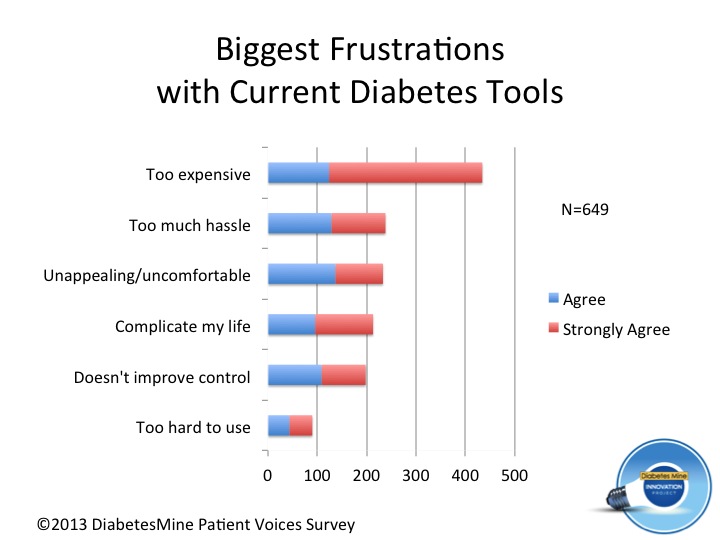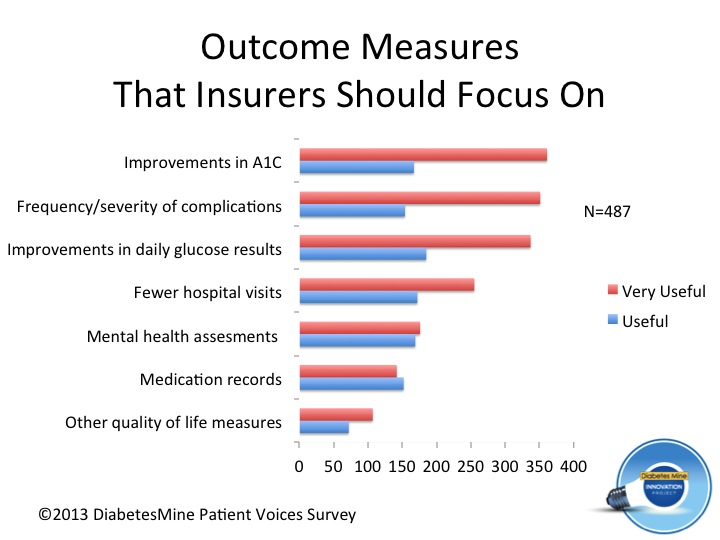Our Survey Diabetes Patients Rank Tech Tools, Quality of Life - moorewitherrom
Today we'ray at Stanford School of Medicine conducting the 2013 DiabetesMine Innovation Summit — a gathering of key stakeholders in which patients represent every bit catalysts for change.
We're excited to share with you all the results of our long-suffering-views-on-diabetes-technical school survey, being undraped at the Elevation today. Hera's the scoop:
The DiabetesMine 2013 Patient Voices Follow has found that according to patients, the factors that would most improve their quality of liveliness are not being sufficiently met away diabetes technology currently in the market. The survey shows patients attribute this to two factors: one being the technology itself, and the other being limitations on access to the devices.
The DiabetesMine Patient Voices Survey includes information from nearly 800 patients and caregivers live online, and was conducted in the summer of 2013. Information technology was promoted present at the patient role news site DiabetesMine.com, and connected TuDiabetes, Diabetes Daily and respective other diabetes networking sites. Respondents are therefore a self-selected aggroup of the most active and engaged patients and caregivers.
Participants overwhelmingly stated that the most important quality of life (QOL) improvements they look for are, in order of priority:
1. "fewer glucose highs and lows"
2. "feel more in keep in line of my own fear"
3. "less daily hassle"
Interestingly, "fewer shots" and "less fingerpricks" (often touted by vendors and the mainstream media) rated toward the bed of a list of seven QOL priorities.

Technology Limitations
Among this aggroup of extremely engaged respondents, over 40% reportable that they "never" download or perspective reports of the results from their fingerstick glucose meters, and 60% ne'er do so with their continuous glucose monitors. At the same time, well-nig 35% aforesaid they make utilize software Beaver State mobile apps for diabetes data logging once a month or more.
Respondents indicated that the changes most needed to make diabetes logging data more valuable to patients, ready of priority are:
- programs that billet and foreground trends in the information
- power to give recommendations for changes in therapy — rather than just storing and displaying raw data
- capability to view and analyze their glucose data, insulin dosing records, food for thought and exercise records and former relevant data all jointly in one place, and
- guarantee that a doc or diabetes educator would take the time to brushup and discuss the data with patients

Additionally, sight respondents entered more than 3,200 written comments in reply to a number of open-terminated questions; a consistent theme was frustration complete lack of interoperability and integration (with other devices and with Mac/Apple iOs), and lack of data sharing capabilities.

When asked about overall use of smartphone apps for diabetes purposes, less than one-quarter of these highly bound patients reported using them. Even among those WHO did, utilization of diet and food apps hierarchal first, followed by exercise tracking, and glucose logging apps ranked last, being used by only 19%.

Access Limitations
When asked to plac their biggest frustrations with current diabetes tools, respondents overwhelmingly chose "too expensive" over issues of excogitation or ease of use.

Two-thirds of respondents also declared that access via their insurance is "highly influential" in the diabetes tools they take to prevail and use.

Vehemence happening the financial burthen was underscored in a dubiousness roughly use of continuous glucose monitors, powerful devices that have nevertheless been slow to gain stack adoption. When asked to rank the biggest drawbacks of these devices, 45% ranked "down of pocket costs too high" as a bigger issue than other communal complaints, including "galling alarms," "awkward to wear," "too much metre investing," and "call for easier fashio to analyze the data."

Need
We also asked patients to value factors that would likely surgery selfsame likely motivate them to put extra effort into their diabetes management. The pass two choices were "positive feedback from healthcare providers" (i.e. apiculate cocksure reinforcement) — followed closely by "incentive programs" (financial rewards, discounts, etc.)

In the comments section, respondents consistently mentioned the hope to:
- "have a diabetes mentor" surgery "work in a group or team"
- receive positive feedback for their efforts to control glucose levels "regardless of the results," and
- have a system in place that holds patients accountable, while assisting them to puddle discussion adjustments "in a timely manner"
With the Health care Establishment's current stress on Patient Deference/ Medication Attachment, these responses appear to highlight a need to gain break understanding of patients' real-world concerns and motivators.
Patient Perspectives on 'Improved Outcomes'
When asked which outcome measures Insurers should nidus happening most in determining which diabetes tools to cover, respondents indicated that two factors are of nearly equal importance to the currently used A1C (test of three-month glucose level averages):
- the frequency and severity of diabetes complications, and
- improvements in daily glucose results (i.e. more every day "time in range" — as opposed to A1C, which indicates only an average floor over the previous 120 days)

In the extensive comments section, survey participants called for Insurers to diversify their focus beyond the A1C test, which "does not sufficiently reflect the current or long well-being of patients with diabetes." Respondents would like to see early measures of "forbearing gratification, better overall health and fewer complications."
To this end, survey participants called for diabetes decision-makers to help them with the following:
- Obtain devices that are comfortable, discreet and hi-fi
- That can prefigure glucose highs and lows
- That require less thinking most the daily concerns of diabetes, assist with much time in range, less hypoglycemia
- Move on the far side patented systems to allow data joint for a "full picture" of diabetes direction, and give patients unrestricted access to their own medical examination information
- Call for less hassle with insurance / billing — both in terms of insurance filing requirements and entree to indispensable expendable ongoing supplies such as glucose test strips
We have a nifty infographic summing this altogether rising, coming presently. Plus the full report of go over results will make up posted along Slideshare shortly.
Our corking desire here at 'Mine is that the Powers That Be can use this information to punter deliver on the anticipat of diabetes technology — the topic of nowadays's Summit, course!

This content is created for Diabetes Mine, a leading consumer wellness blog focused on the diabetes community that joined Healthline Media in 2015. The Diabetes Mine team is made up of informed patient advocates who are also trained journalists. We focus on providing content that informs and inspires people affected by diabetes.
Source: https://www.healthline.com/diabetesmine/diabetes-patients-rank-biggest-drawbacks-of-technology-tools
Posted by: moorewitherrom.blogspot.com


0 Response to "Our Survey Diabetes Patients Rank Tech Tools, Quality of Life - moorewitherrom"
Post a Comment